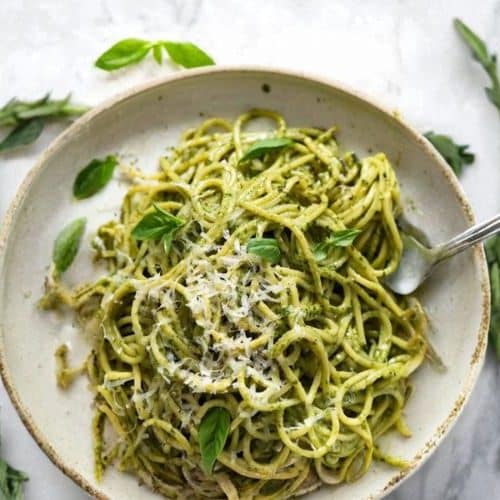
Spaghetti with Basil Pesto
This silky pesto pasta is a fresh, vibrant dish featuring homemade pesto sauce emulsified with pasta cooking water for the ideal texture. Quick to prepare and bursting with flavor, it’s perfect for satisfying weeknight dinners or simple entertaining.
Equipment
- 1 large pot
- 1 colander
- 1 Mixing bowl
- 1 measuring cup
- 1 pair of tongs or pasta fork
Ingredients
- 1 batch homemade pesto or ½ cup store-bought
- 300 to 350 grams pasta ziti, penne, or spaghetti recommended
- 2 teaspoons salt for boiling water
- ¾ cup reserved pasta cooking water
- Parmesan cheese for garnish, to taste
Instructions
- Prepare the Pasta Water with Salt: Begin by filling a large pot with plenty of water—this will ensure the pasta cooks evenly and doesn’t stick together. Place the pot on the stove over high heat and bring the water to a vigorous boil. Once boiling, add 2 teaspoons of salt to the water. The salt seasons the pasta as it cooks, enhancing its natural flavor. Stir gently to dissolve the salt evenly throughout the water.
- Cook the Pasta to Al Dente: Carefully add 300 to 350 grams of your chosen pasta—ziti, penne, or spaghetti all work wonderfully—to the boiling salted water. Stir immediately to prevent the noodles from sticking to each other or the pot. Allow the pasta to cook uncovered, following the timing suggested on the package, usually around 9 to 12 minutes, until the pasta reaches an al dente texture. Al dente means the pasta should be tender but still firm when bitten—this texture will hold up beautifully once combined with the pesto sauce.
- Reserve Pasta Cooking Water: Just before draining the pasta, use a measuring cup or ladle to scoop out approximately ¾ cup of the hot pasta cooking water. This water contains starch released from the pasta, which is crucial for creating a smooth, silky pesto sauce that clings to every noodle. Set this reserved water aside for later use.
- Drain the Pasta Gently: Pour the pasta into a colander placed in the sink to drain off the cooking water. Allow it to sit for about 30 seconds to 1 minute so excess water drips off, but don’t let the pasta sit too long or it may become sticky. Avoid rinsing the pasta, as rinsing washes away the starch needed to bind the sauce.
- Transfer Pasta to a Mixing Bowl: Immediately transfer the drained pasta into a large mixing bowl. Avoid placing the pasta back into the hot cooking pot, as the residual heat can cause the pesto to discolor or wilt prematurely. The bowl provides a perfect environment for tossing and coating the pasta evenly.
- Add Pesto and Pasta Water for Coating: Spoon 1 full batch of homemade pesto (or about ½ cup of store-bought pesto) over the pasta. Pour in about ¼ cup of the reserved pasta water to start. Using tongs or a large spoon, gently toss the pasta and pesto together. The starch-rich water helps emulsify the pesto oil, creating a glossy, silky sauce that clings to every strand. If the pasta looks dry or the sauce feels thick, gradually add more reserved water in small increments, tossing continuously, until you achieve a luxuriously smooth, saucy consistency.
- Taste and Adjust Seasoning: Pause to taste your pesto pasta. The saltiness of the pasta water usually seasons the dish sufficiently, but you may want to add a pinch of salt or freshly ground black pepper to balance the flavors perfectly. For those who enjoy a touch of brightness, a squeeze of fresh lemon juice can be added here to lift the dish.
- Serve Immediately with Parmesan: Once the pasta is coated evenly and seasoned to your liking, serve it right away. Plate the pasta into bowls or onto plates and garnish generously with freshly grated Parmesan cheese. The salty, nutty notes of Parmesan complement the herbal richness of the pesto beautifully.
- Storage and Serving Tips: If you have leftovers, transfer them to a tightly sealed airtight container and refrigerate promptly. Avoid reheating pesto pasta, as heat can cause the basil to darken and the texture to become dull. Instead, bring the pasta to room temperature before serving—the flavors remain vibrant and the dish is just as satisfying cold or at room temperature.
Notes
This recipe is designed to showcase the best qualities of homemade pesto, but it works just as well with a quality store-bought version—simply adjust the amount used as store-bought pesto tends to be more concentrated in flavor.
For an ideal coating of pesto, stick to 300 grams of pasta; using more pasta may dilute the vibrant basil flavor.
Always reserve pasta water before draining, as it’s key to emulsifying the sauce and achieving that perfect silky texture.
Avoid tossing the pesto pasta on direct heat since heat can cause the basil to turn dark and bitter. Leftovers are best enjoyed at room temperature rather than reheated.